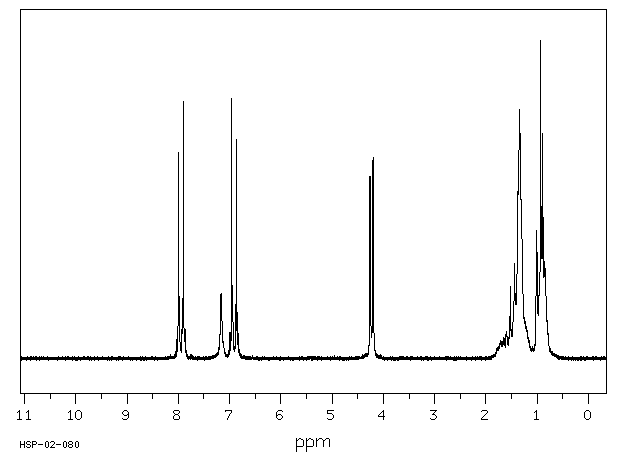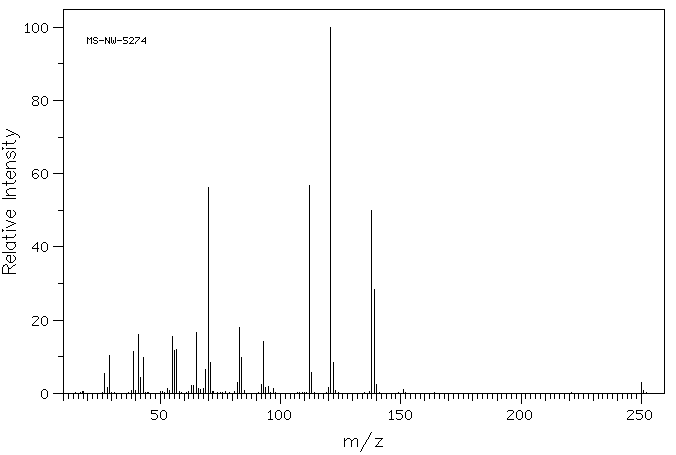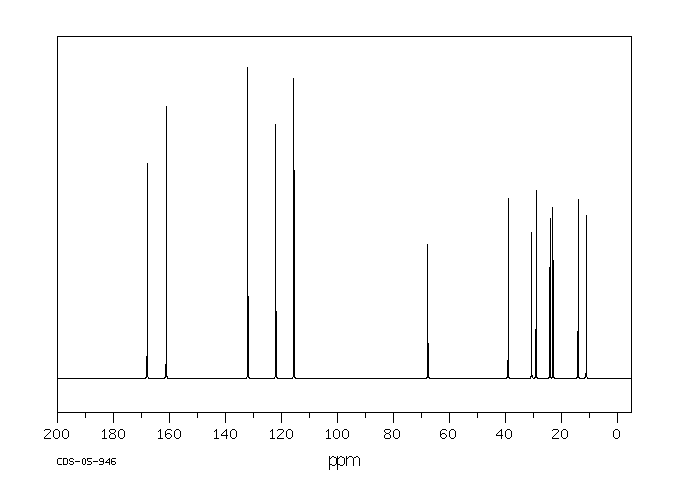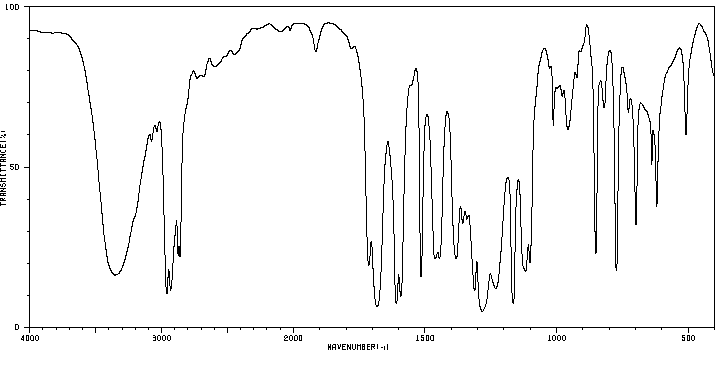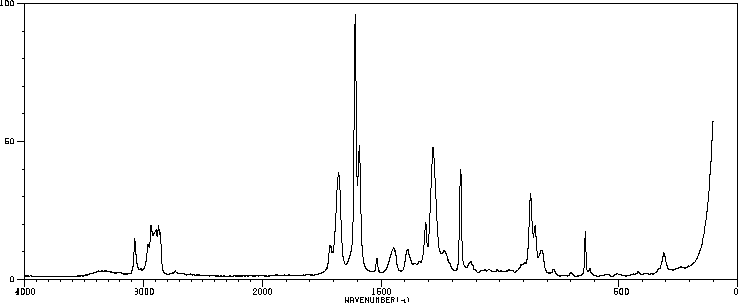尼泊金辛酯 | 5153-25-3
-
物化性质
-
计算性质
-
ADMET
-
安全信息
-
SDS
-
制备方法与用途
-
上下游信息
-
文献信息
-
表征谱图
-
同类化合物
-
相关功能分类
-
相关结构分类
物化性质
-
沸点:270°C/50mmHg(lit.)
-
密度:1.035±0.06 g/cm3(Predicted)
-
LogP:5.292 (est)
-
稳定性/保质期:
在常温常压下保持稳定
计算性质
-
辛醇/水分配系数(LogP):4.5
-
重原子数:18
-
可旋转键数:8
-
环数:1.0
-
sp3杂化的碳原子比例:0.533
-
拓扑面积:46.5
-
氢给体数:1
-
氢受体数:3
安全信息
-
危险品标志:Xn
-
安全说明:S26,S36/37/39
-
危险类别码:R36/37/38
-
海关编码:2918290000
-
危险性防范说明:P261,P264,P272,P280,P302+P352+P333+P313+P363,P305+P351+P338+P337+P313,P501
-
危险性描述:H315,H317,H319
-
储存条件:请将药品存放在避光、阴凉干燥的地方,并密封保存。
SDS
SAFETY DATA SHEET
Section 1. IDENTIFICATION
Product name: 2-Ethylhexyl 4-Hydroxybenzoate
Revision number: 5
Section 2. HAZARDS IDENTIFICATION
GHS classification
PHYSICAL HAZARDS Not classified
HEALTH HAZARDS
Skin corrosion/irritation Category 2
Category 2A
Serious eye damage/eye irritation
Skin sensitization Category 1
Not classified
ENVIRONMENTAL HAZARDS
GHS label elements, including precautionary statements
Pictograms or hazard symbols
Signal word Warning
Hazard statements Causes skin irritation
Causes serious eye irritation
May cause an allergic skin reaction
Precautionary statements:
Avoid breathing dust/fume/gas/mist/vapours/spray.
[Prevention]
Contaminated work clothing should not be allowed out of the workplace.
Wash hands thoroughly after handling.
Wear protective gloves/eye protection/face protection.
IF IN EYES: Rinse cautiously with water for several minutes. Remove contact lenses,
[Response]
if present and easy to do. Continue rinsing.
If eye irritation persists: Get medical advice/attention.
IF ON SKIN: Gently wash with plenty of soap and water.
If skin irritation or rash occurs: Get medical advice/attention.
Wash contaminated clothing before reuse.
Section 3. COMPOSITION/INFORMATION ON INGREDIENTS
Substance/mixture: Substance
Components: 2-Ethylhexyl 4-Hydroxybenzoate
Percent: >98.0%(LC)(T)
5153-25-3
CAS Number:
Synonyms: 2-Ethylhexylparaben , 4-Hydroxybenzoic Acid 2-Ethylhexyl Ester , 4-Hydroxybenzoic
Acid Octyl Ester , Octyl 4-Hydroxybenzoate , Octylparaben
Chemical Formula: C15H22O3
2-Ethylhexyl 4-Hydroxybenzoate
Section 4. FIRST AID MEASURES
Inhalation: Remove victim to fresh air and keep at rest in a position comfortable for breathing.
Get medical advice/attention if you feel unwell.
Skin contact: Remove/Take off immediately all contaminated clothing. Gently wash with plenty of
soap and water. If skin irritation or rash occurs: Get medical advice/attention.
Eye contact: Rinse cautiously with water for several minutes. Remove contact lenses, if present
and easy to do. Continue rinsing. If eye irritation persists: Get medical
advice/attention.
Ingestion: Get medical advice/attention if you feel unwell. Rinse mouth.
Protection of first-aiders: A rescuer should wear personal protective equipment, such as rubber gloves and air-
tight goggles.
Section 5. FIRE-FIGHTING MEASURES
Suitable extinguishing Dry chemical, foam, water spray, carbon dioxide.
media:
Unsuitable extinguishing Solid streams of water
media:
Precautions for firefighters: Fire-extinguishing work is done from the windward and the suitable fire-extinguishing
method according to the surrounding situation is used. Uninvolved persons should
evacuate to a safe place. In case of fire in the surroundings: Remove movable
containers if safe to do so.
Special protective When extinguishing fire, be sure to wear personal protective equipment.
equipment for firefighters:
Section 6. ACCIDENTAL RELEASE MEASURES
Use personal protective equipment. Keep people away from and upwind of spill/leak.
Personal precautions,
protective equipment and Ensure adequate ventilation. Entry to non-involved personnel should be controlled
emergency procedures: around the leakage area by roping off, etc.
Environmental precautions: Prevent product from entering drains.
Methods and materials for Absorb spilled material in a suitable absorbent (e.g. rag, dry sand, earth, saw-dust).
containment and cleaning In case of large amount of spillage, contain a spill by bunding. Adhered or collected
up: material should be promptly disposed of, in accordance with appropriate laws and
regulations.
Section 7. HANDLING AND STORAGE
Precautions for safe handling
Technical measures: Handling is performed in a well ventilated place. Wear suitable protective equipment.
Prevent generation of vapour or mist. Wash hands and face thoroughly after
handling.
Use a ventilation, local exhaust if vapour or aerosol will be generated.
Advice on safe handling: Avoid contact with skin, eyes and clothing.
Conditions for safe storage, including any
incompatibilities
Storage conditions: Keep container tightly closed. Store in a cool and dark place.
Store away from incompatible materials such as oxidizing agents.
Packaging material: Comply with laws.
Section 8. EXPOSURE CONTROLS / PERSONAL PROTECTION
Engineering controls: Install a closed system or local exhaust as possible so that workers should not be
exposed directly. Also install safety shower and eye bath.
Personal protective equipment
Respiratory protection: Vapor respirator. Follow local and national regulations.
Protective gloves.
Hand protection:
Eye protection: Safety glasses. A face-shield, if the situation requires.
Skin and body protection: Protective clothing. Protective boots, if the situation requires.
2-Ethylhexyl 4-Hydroxybenzoate
Section 9. PHYSICAL AND CHEMICAL PROPERTIES
Physical state (20°C): Liquid
Form: Clear
Colorless - Pale yellow
Colour:
Odour: No data available
pH: No data available
Melting point/freezing point:No data available
270°C/6.7kPa
Boiling point/range:
Flash point: No data available
Flammability or explosive
limits:
No data available
Lower:
Upper: No data available
1.04
Relative density:
Solubility(ies):
No data available
[Water]
[Other solvents] No data available
Section 10. STABILITY AND REACTIVITY
Chemical stability: Stable under proper conditions.
Possibility of hazardous No special reactivity has been reported.
reactions:
Incompatible materials: Oxidizing agents
Hazardous decomposition Carbon monoxide, Carbon dioxide
products:
Section 11. TOXICOLOGICAL INFORMATION
Acute Toxicity: No data available
Skin corrosion/irritation: No data available
Serious eye No data available
damage/irritation:
Germ cell mutagenicity: No data available
Carcinogenicity:
IARC = No data available
No data available
NTP =
Reproductive toxicity: No data available
Section 12. ECOLOGICAL INFORMATION
Ecotoxicity:
Fish: No data available
Crustacea: No data available
Algae: No data available
Persistence / degradability: No data available
Bioaccumulative No data available
potential(BCF):
Mobility in soil
Log Pow: No data available
Soil adsorption (Koc): No data available
Henry's Law No data available
constant(PaM3/mol):
Section 13. DISPOSAL CONSIDERATIONS
Recycle to process, if possible. Consult your local regional authorities. You may be able to burn in a chemical
incinerator equipped with an afterburner and scrubber system. Observe all federal, state and local regulations when
disposing of the substance.
2-Ethylhexyl 4-Hydroxybenzoate
Section 14. TRANSPORT INFORMATION
Hazards Class: Does not correspond to the classification standard of the United Nations
UN-No: Not listed
Section 15. REGULATORY INFORMATION
Safe management ordinance of dangerous chemical product (State Council announces on January 26, 2002
and revised on February 16,2011): Safe use and production, the storage of a dangerous chemical, transport,
loading and unloading were prescribed.
SECTION 16 - ADDITIONAL INFORMATION
N/A
制备方法与用途
尼泊金酯的特性为:随着对羟基苯甲酸酯中烷基的增大,其水溶性逐渐减小而脂溶性逐渐增加,毒性也随之降低,但抗菌活性增强。其中碳数为11、12的烷基链酯具有最大的抗菌活性。此外,杀菌抑菌作用随醇烃基碳原子数的增加而增强。例如,尼泊金辛酯对酵母菌发育的抑制作用是丁酯的50倍,比乙酯强约200倍;然而,在水中的溶解度则会随着醇烃基碳原子数的增加而降低。通常将几种产品混合使用以提高溶解度,并通过增效作用提升防腐能力。
防腐剂尼泊金酯(Ester of P-hydroxybenzoic acid)是一种低毒、中性防腐剂,具有广泛的抗菌范围,不受酸碱性影响,化学性质稳定。已被广泛应用于食品、饮料、化妆品和医药领域。国内主要生产的包括尼泊金甲酯、乙酯、丙酯和丁酯等。尼泊金庚、辛酯尚未在国内生产,但国外常作为含酒精饮料的防腐剂使用。随着人们对生啤酒需求的不断提高,尼泊金庚、辛酯的工业化生产和应用具有很大的市场潜力。
用途尼泊金酯是一种低毒中性防腐剂,具有广泛的抗菌范围和不受酸碱性影响的特点,化学性质稳定。它已被广泛应用于食品、饮料、化妆品和医药等领域,其中仅在化妆品行业的年需求量就达数百吨之多。尼泊金酯因其毒性低、无刺激性和适用pH范围广等特点,在食品、日化及药物等行业中被广泛应用,并被指定为我国重点发展的食品防腐剂之一。
应用尼泊金酯是一种高效且低毒的广谱食品防腐剂,是国际公认的三大食品防腐剂之一。作为防腐剂,尼泊金乙酯、丙酯和丁酯等已经得到了广泛的应用,而高级酯如尼泊金辛酯还未实现工业化生产与应用。尼泊金辛酯具有毒性小、防腐效果好且用量少的优点,并能与其他尼泊金低级酯或苯甲酸复配使用以增强效果、提高水溶性和扩大抗菌谱系。该产品具有良好的市场前景和开发价值,对于合成工艺、抑菌特性和具体应用的研究很有必要。
尼泊金酯对生啤酒有很好的保鲜性能,其中尼泊金辛酯的效果最佳,尼泊金己酯和庚酯也不错。它们可以将生啤酒的保鲜期延长4~5倍,并且与二氧化氯相比,用量仅为万分之几。联合国粮农组织、世界卫生组织、美国食品药物管理局及我国相关机构都将尼泊金酯列为安全防腐剂(ADI 0~10 mg/kg)。
合成方法尼泊金酯通常通过对-羟基苯甲酸和相应醇进行酯化反应来合成,共沸带水剂如石油醚、苯、甲苯或环己烷等用于及时移除酯化过程中产生的水分。产品经过减压蒸馏或重结晶的方法精制而成。
上下游信息
-
上游原料
中文名称 英文名称 CAS号 化学式 分子量 对羟基苯甲酸 4-hydroxy-benzoic acid 99-96-7 C7H6O3 138.123
反应信息
-
作为产物:描述:参考文献:名称:温和条件下芳基铵盐合成酚类摘要:开发了一种在温和条件下由缺电子芳基铵盐或杂芳基铵盐合成酚类的通用方法。苯甲醛肟、乙酰氧肟酸和盐酸羟胺分别作为氢氧化物替代物进行了研究。使用这些氢氧化物替代物,可以以 20-98% 的收率制备一系列酚类。DOI:10.1021/acs.joc.2c01133
文献信息
-
[EN] METALOXYPHTHALOCYANINE COMPOUNDS<br/>[FR] COMPOSES DE METALOXYPHTALOCYANINE
-
Metabolism and Pharmacokinetics of Oxazaphosphorines作者:Alan V. Boddy、S. Murray YuleDOI:10.2165/00003088-200038040-00001日期:2000.4The 2 most commonly used oxazaphosphorines are cyclophosphamide and ifosfamide, although other bifunctional mustard analogues continue to be investigated. The pharmacology of these agents is determined by their metabolism, since the parent drug is relatively inactive. For cyclophosphamide, elimination of the parent compound is by activation to the 4-hydroxy metabolite, although other minor pathways of inactivation also play a role. Ifosfamide is inactivated to a greater degree by dechloroethylation reactions. More robust assay methods for the 4-hydroxy metabolites may reveal more about the clinical pharmacology of these drugs, but at present the best pharmacodynamic data indicate an inverse relationship between plasma concentration of parent drug and either toxicity or antitumour effect. The metabolism of cyclophosphamide is of particular relevance in the application of high dose chemotherapy. The activation pathway of metabolism is saturable, such that at higher doses (greater than 2 to 4 g/m2) a greater proportion of the drug is eliminated as inactive metabolites. However, both cyclophosphamide and ifosfamide also act to induce their own metabolism. Since most high dose regimens require a continuous infusion or divided doses over several days, saturation of metabolism may be compensated for, in part, by auto-induction. Although a quantitative distinction may be made between the cytochrome P450 isoforms responsible for the activating 4-hydroxylation reaction and those which mediate the dechloroethylation reactions, selective induction of the activation pathway, or inhibition of the inactivating pathway, has not been demonstrated clinically. Mathematical models to describe and predict the relative contributions of saturation and autoinduction to the net activation of cyclophosphamide have been developed. However, these require careful validation and may not be applicable outside the exact regimen in which they were derived. A further complication is the chiral nature of these 2 drugs, with some suggestion that one enantiomer may have a favourable profile of metabolism over the other. That the oxazaphosphorines continue to be the subject of intensive investigation over 30 years after their introduction into clinical practice is partly because of their antitumour activity. Further advances in analytical and molecular pharmacological techniques may further optimise their use and allow rational design of more selective analogues.最常用的两种噁唑磷酰胺类药物是环磷酰胺和异环磷酰胺,尽管其他双功能烷化剂仍在研究中。这些药物的药理学特性由其代谢途径决定,因为母体药物相对不活跃。环磷酰胺通过激活生成4-羟基代谢物来消除母体化合物,尽管其他次要的失活途径也起作用。异环磷酰胺通过脱氯乙基化反应更大幅度地失活。更强大的4-羟基代谢物检测方法可能揭示这些药物的临床药理学更多信息,但目前最佳药效学数据显示,母体药物血浆浓度的逆向关系与毒性或抗肿瘤效应相关。环磷酰胺的代谢在应用高剂量化疗时尤为相关。代谢激活途径是可饱和的,因此在高剂量(大于2至4 g/m²)下,药物以失活代谢物的形式排出的比例更大。然而,环磷酰胺和异环磷酰胺都能诱导自身代谢。由于大多数高剂量方案需要连续输注或几天的分次给药,代谢饱和可通过自诱导部分得到补偿。尽管可以对负责激活4-羟基化反应的细胞色素P450同工酶和介导脱氯乙基化反应的同工酶进行定量区分,但临床上尚未证明选择性诱导激活途径或抑制失活途径的能力。描述和预测饱和和自诱导对环磷酰胺净激活相对贡献的数学模型已开发出来。然而,这些模型需要仔细验证,并且可能不适用于它们所衍生的给药方案之外。另一个复杂之处在于这两种药物的手性本质,有迹象表明一种对映体可能比另一种具有更有利的代谢特征。由于其抗肿瘤活性,噁唑磷酰胺类药物在引入临床实践30多年后,仍然是广泛研究的主题。进一步发展分析和分子药理学技术可能进一步优化它们的使用,并允许设计更具选择性的类似物。
-
METHOD OF PROVING AUTHENTICITY, SIGNAL CONVERSION METHOD, POLYMER WELDING METHOD, METHOD OF PRODUCING LITHOGRAPHIC PRINTING PLATE, INK FOR PRINTING, TONER, AND HEAT RAY-SHIELDING MATERIAL, EACH USING NAPHTHALOCYANINE COMPOUND, AND METHOD OF PRODUCING NAPHTHALOCYANINE COMPOUND申请人:Kimura Keizo公开号:US20110311911A1公开(公告)日:2011-12-22Disclosed is a method of proving the authenticity of goods or a support comprising using a compound represented by Formula (I). wherein, in Formula (I), each of R 11 to R 46 independently represents a hydrogen atom or a substituent group, wherein when a benzene ring is substituted with any of R 11 to R 46 , any groups adjacent to each other among R 11 to R 46 may be bonded each other to form a ring; M represents a hydrogen atom, a metal ion, or a group containing a metal ion; and n represents 1 or 2. The infrared absorption efficiency is high and the deterioration in infrared absorption over time is ameliorated. The infrared absorption efficiency is high and the deterioration in infrared absorption over time is ameliorated.
-
Method for the manufacture of hydroxy aromatic monocarboxylic acids申请人:Bromine Compounds Ltd.公开号:EP0461322A1公开(公告)日:1991-12-18A method for preparing hydroxy aromatic carboxylic acids, or the ester derivatives thereof, comprises the carbonylation of a hydroxy aromatic bromide in the presence of a catalytic amount of a transition element of group VIII of the Periodic Table on a carbon support, at a pH of above 8, in the absence of any promoter.The reaction is carried out at a temperature in the range of between 140°C to 200°C. The resulting products are obtained in high yields and of high purity. The method has particular applicability to the manufacture of 6-carboxy-2-naphthol and 4-hydroxy-4'-carboxy-biphenyl.
-
Negative charge controlling agent and static charge image developing toner using the same, and method for producing the same申请人:Ishimoto Takayuki公开号:US20060083999A1公开(公告)日:2006-04-20A negative charge controlling agent, wherein: the negative charge controlling agent comprises polycondensation product obtained by a polycondensation reaction of phenols and aldehydes; and the phenols comprises a (A) mononucleus phenolic compound which has one phenolic hydroxy group in which a hydrogen is bonded at the ortho position of a hydroxyl group of the phenolic hydroxy group and a (B) multinucleus phenolic compound which has at least two phenolic hydroxy groups in which a hydrogen is bonded at the ortho position of a hydroxyl group of each of the phenolic hydroxy group; and the content of the (B) phenolic compound in the phenols is 1 to 30 mol %.
表征谱图
-
氢谱1HNMR
-
质谱MS
-
碳谱13CNMR
-
红外IR
-
拉曼Raman
-
峰位数据
-
峰位匹配
-
表征信息


